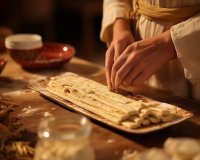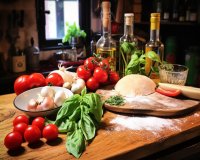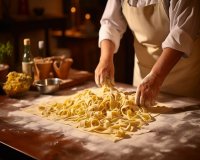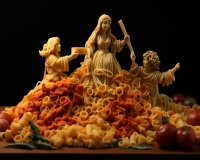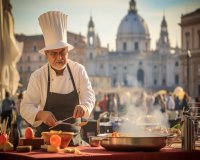Mastering Traditional Italian Cooking in Rome
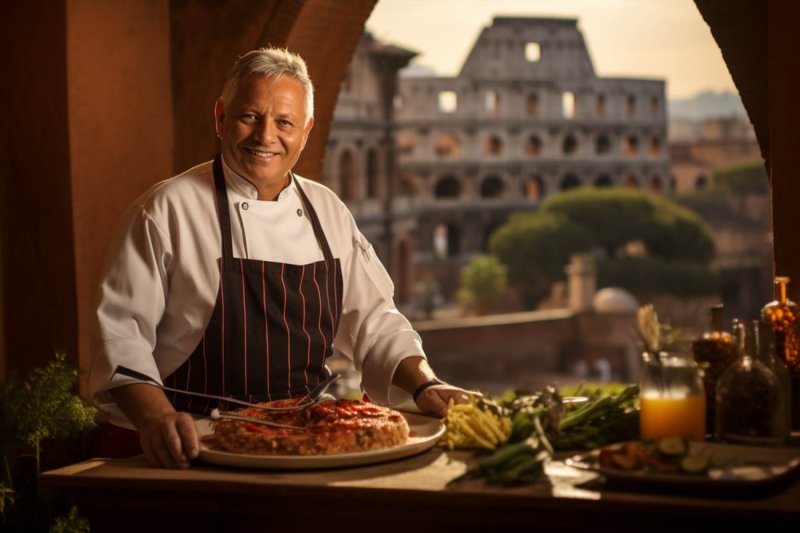
Mastering Traditional Italian Cooking in Rome
Rome, the eternal city, is not just known for its historic sites and beautiful architecture; it's also a paradise for food lovers. And when it comes to Italian cuisine, what better place to learn and master the art of traditional Italian cooking than Rome itself?
Italian cuisine is renowned worldwide for its exquisite flavors, regional diversity, and centuries-old recipes passed down through generations. If you're a food enthusiast or simply want to enhance your culinary skills, taking a cooking course in Rome is an experience like no other.
Why Choose Rome for Traditional Italian Cooking?
Rome is the capital of Italy and a hub of traditional Italian cuisine. It's where ancient recipes and modern culinary techniques merge, creating a vibrant food scene that's both rooted in history and constantly evolving. Here are some compelling reasons to consider mastering traditional Italian cooking in Rome:
- Roman History: Rome's culinary heritage is deeply intertwined with its history. By learning to cook in Rome, you'll gain a deeper appreciation of the historical context behind each dish.
- Local Ingredients: Rome is surrounded by fertile farmland, providing access to fresh, high-quality ingredients. Learning to cook with these ingredients ensures an authentic experience.
- Cultural Immersion: Italian culture is an essential ingredient in its cuisine. When you learn to cook in Rome, you're immersing yourself in a rich and diverse culture.
- Expert Instructors: Rome boasts a range of cooking schools with expert chefs who are passionate about sharing their knowledge of traditional Italian cooking.
What You'll Learn
When you embark on a journey to master traditional Italian cooking in Rome, you'll dive into a world of flavors, techniques, and culinary secrets. Here are some of the key aspects you can expect to learn:
- **Pasta Making:** Pasta is a staple of Italian cuisine. You'll learn to make various pasta shapes from scratch, from the classic fettuccine to regional favorites like orecchiette.
- **Sauces:** No Italian meal is complete without a delicious sauce. You'll master the art of making traditional sauces like Marinara, Alfredo, and Pesto.
- **Pizza:** Explore the secrets of crafting the perfect pizza, from kneading the dough to selecting the finest toppings.
- **Antipasti:** Learn to create the perfect appetizers, from bruschetta to caprese salad, setting the stage for an unforgettable Italian feast.
- **Dolci (Desserts):** Satisfy your sweet tooth with delectable desserts like tiramisu, cannoli, and panna cotta.
- **Wine Pairing:** Discover the art of pairing wine with Italian dishes, enhancing the overall dining experience.
Cooking Schools in Rome
Rome offers a variety of cooking schools and workshops catering to all skill levels. Here are a few notable options:
| School |
Location |
Specialty |
| Cooking with Nonna |
Rome Center |
Homestyle Italian cooking |
| Ciao Roma |
Trastevere |
Roman and regional specialties |
| Rome Cooking School |
Prati |
Comprehensive Italian cuisine |
Each school has its unique approach and specialties, so you can choose the one that best aligns with your culinary interests.
Bringing Home Italian Culinary Skills
After mastering traditional Italian cooking in Rome, you'll have a valuable skill set that you can bring home and share with friends and family. Whether you're interested in pursuing a career in the culinary arts or simply want to impress your loved ones with authentic Italian dishes, the knowledge gained in Rome will stay with you for a lifetime.
In conclusion, Rome is the ultimate destination for anyone eager to master traditional Italian cooking. It's a journey through history, culture, and the rich tapestry of flavors that make Italian cuisine so beloved worldwide. So, if you're looking to add a little taste of Italy to your life, why not start your culinary adventure in the heart of Rome?
Rome: Traditional Cooking Class in the Jewish Ghetto
Learn how to make fresh pasta from scratch in the heart of the Jewish Quarter. Take part in a fun cooking class in Rome, taste your delicious creations, and bring home traditional Italian recipes.
About this activity
Take your authentic roman-style pasta or gnocchi cooking class in the Jewish district of Rome seen in the Stanley Tucci’s show. Take a break from visiting the city by meeting local people and learning how to make a typical Roman dinner menu from scratch.
Meet your host in the heart of the Jewish Ghetto. Enjoy the easy-going happy lifestyle, which the Ghetto is famous for. Head to the restaurant and meet the Chef ready for you to reveal secrets and recipes.
This is a hands-on class, but if you’d just like to be a spectator you can relax, watching the chef working, with a glass of wine. You’ll learn to make home-made pasta from scratch, cleaning and preparing seasonal vegetables to fry and tasting dessert that all roman grandmas used to cook for local kids.
Season menu is the key for a good cooking class. Learning history and legend around the Jewish district and its unique food style.
Let’s put our hands in the dough. Start your cooking class learning how to make fresh pasta from scratch. Using our grandmas’ style you will be able to make it again when back home. Seasonal food is a must in Rome, in the winter class, you’ll have the opportunity to learn how to peel artichokes to be cooked at the Jewish Style, one of the highlights of Roman cuisine.
In the Summer’s class, you’ll learn how to prepare zucchini flowers or any other amazing fresh vegetable to make the original “fritto romano”. In the end taste the amazing torta di ricotta e visciola, the famous ricotta cheesecake made with simple and delicious ingredients.
Book your pasta cooking class if you look for an authentic and crazy experience in the Jewish district. The experience is suitable to everyone, kids, vegan people, vegetarians are welcome. The style is authentic and easy-going. Do not expect a scholar class, but nice time together with local people, learning how to cook the dishes of the tradition.
The pasta made in the class is not gluten-free, anyway if you can touch flour with no problem, you can join the class then eating gluten free pasta (packaged). The restaurant is not kosher.
Includes
- 3-course meal consisting of fresh homemade pasta, a seasonal main course, and a special traditional dessert
- Italian wine and bottled water
- All kitchen and cooking equipment
- Personal shopping
- Additional food not included in the program
- Hotel pickup and drop off
Not suitable for wheelchair users.
Meeting Point
You will meet the guide at Piazza Mattei n.12 outside the door.
Important Information
Not allowed: Pets
Please note that these allergens can be present in the tastings: milk, eggs, soya, mustard, nuts and gluten. This cooking class is not kosher.
Introduction to Traditional Italian Cuisine in Rome
Rome, the eternal city, is not only famous for its rich history and iconic landmarks, but it's also a paradise for food lovers. Traditional Italian cuisine in Rome is a journey through the heart and soul of the country, where flavors, aromas, and centuries-old recipes come together to create an unforgettable culinary experience.
Roman Staples
When talking about traditional Italian cuisine in Rome, there are a few staples that immediately come to mind:
- Pasta: Pasta is a cornerstone of Italian cuisine, and in Rome, you'll find classics like Cacio e Pepe (cheese and pepper) and Amatriciana (tomato, pecorino cheese, and guanciale) served to perfection. The pasta in Rome is always cooked al dente, creating a delightful texture.
- Pizza: While Naples may be the birthplace of pizza, Rome has its own style. Roman pizza is typically thin and crispy, and you can't leave without trying a slice of classic Margherita or a Roman specialty like the Pizza Bianca, a simple yet delicious pizza with olive oil and salt.
- Supplì: These rice croquettes, often filled with mozzarella and ragù, are a beloved Roman street food. The crispy exterior and gooey, cheesy interior make them irresistible.
- Artichokes: Rome is renowned for its artichokes, especially the Carciofi alla Romana. These tender artichoke hearts are simmered with herbs and olive oil, resulting in a flavorful and aromatic dish.
Roman Dishes with a Story
Italian cuisine is not just about ingredients and techniques; it's also about the stories and traditions that are passed down through generations. In Rome, you'll find dishes with deep historical significance:
| Dish |
History |
| Carbonara |
Legend has it that Carbonara was created by Italian charcoal workers. The name "carbonara" comes from the Italian word "carbone," which means coal. This rich pasta dish with eggs, cheese, pancetta, and black pepper is a true Roman gem. |
| Roman Jewish Cuisine |
Rome's Jewish Ghetto is home to a unique culinary tradition. Dishes like Jewish-style artichokes and fried codfish are a testament to the Jewish community's long history in the city. |
| Coda alla Vaccinara |
This Roman oxtail stew has roots in the "vaccinari" or butchers of the city. It's a hearty, slow-cooked dish that perfectly showcases the Roman approach to using every part of an animal. |
Wine and Desserts
No Italian meal is complete without a glass of wine and a sweet ending. Rome offers a variety of local wines, and you can ask for recommendations to pair with your meal. For dessert, don't miss:
- Tiramisu: This iconic Italian dessert made of layers of coffee-soaked ladyfingers, mascarpone cheese, and cocoa powder is a delightful way to end your meal.
- Roman Ricotta Cake: A delightful pastry filled with creamy ricotta cheese, candied fruit, and a hint of orange zest.
Traditional Italian cuisine in Rome is a celebration of flavors, history, and culture. It's a culinary journey that takes you through the heart of the city and leaves you with a deep appreciation for the rich tapestry of Roman food traditions.
Rome Pasta and Tiramisu Italian Cooking Experience
Explore the heart of Italian culture through its delectable cuisine in this immersive cooking class. Under the guidance of an experienced chef, dive into the art of crafting homemade pasta and traditional Roman sauces, with the option to choose Spritz cocktails over Tiramisu.
About this Activity
Embark on a culinary journey with the preparation of a delightful tiramisu using fresh local ingredients. Learn authentic recipes straight from the expert chef, and after crafting your homemade pasta, select a local sauce to prepare from scratch. Uncover the secrets of great Italian cooking and take home the skills to recreate these dishes for years to come.
What's Included
- Pasta and Tiramisu workshop (if option selected)
- Spritz and Spaghetti workshop (if option selected)
- Fresh hand-made pasta and local ingredients
- 1 glass of wine, 1 glass of prosecco, and unlimited water and soft drinks
- 1 glass of limoncello
- Tiramisu (if option selected)
- Hotel pickup and drop-off
Meeting Point
Meet on Via Cesare Balbo 19.
Price
From 317.54 zł to 231.80 zł per person, saving up to 27%. Check availability and reserve your spot with no upfront payment.
Customer Reviews
Rated 4.9/5 based on 110 reviews, highlighting the exceptional experience of learning from a friendly and skilled chef. Participants praise the value for money, delicious food, and the fun, interactive nature of the class.
The Secrets of Italian Pasta Making in Rome
Italian cuisine is celebrated worldwide for its rich flavors, diverse ingredients, and unique culinary traditions. One of the most iconic elements of Italian food is pasta, and when it comes to pasta, there's no place quite like Rome. The Eternal City is not only famous for its history and architecture but also for its incredible pasta dishes. In this article, we'll uncover the secrets of Italian pasta making in Rome, exploring the artistry and techniques that make Roman pasta truly special.
Roman pasta dishes are characterized by their simplicity and the emphasis on fresh, high-quality ingredients. From Cacio e Pepe to Amatriciana and Carbonara, these classic Roman recipes have been passed down through generations, and each one tells a unique story of Roman culinary heritage.
The Basics of Pasta Making
Before we dive into the secrets, it's important to understand the basics of pasta making. The foundation of great pasta starts with the dough. Roman pasta is typically made using a mix of semolina flour and water, although some recipes might include eggs. The key is to achieve the right consistency – a dough that's not too dry or too wet.
Once the dough is prepared, it's time for shaping. Romans are known for their mastery of various pasta shapes, from the classic spaghetti and fettuccine to more intricate ones like bucatini and pappardelle. The choice of shape can significantly impact the texture and taste of the final dish.
Secrets to Roman Pasta
1. Choosing the Right Ingredients: The first secret to exceptional Roman pasta is using high-quality, local ingredients. Fresh eggs, top-notch Pecorino Romano cheese, and guanciale, a cured pork cheek, are essential for authentic Carbonara.
2. Handcrafting the Pasta: Many traditional Roman pasta dishes are best made by hand. Expert pasta makers in Rome have perfected the art of rolling out dough and creating delicate, uniform shapes. This hands-on approach ensures the right texture and thickness.
3. Mastering the Sauces: Roman sauces are uncomplicated but flavorful. For instance, the secret to Cacio e Pepe is in the emulsification of cheese and pasta water, creating a creamy, peppery sauce that coats each strand of pasta perfectly.
4. Timing is Crucial: Timing is everything when it comes to Roman pasta. Cooking the pasta until al dente is essential to achieve the right texture, and tossing it with the sauce at the perfect moment ensures a harmonious blend of flavors.


